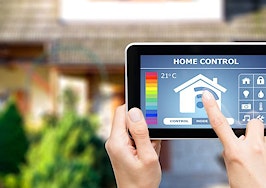- Know the FAA’s droning rules and regulations, disclose drone usage to homeowners and neighbors, and have a plan for any shots you intend to capture.
Many online property listings have photos that fail to highlight the positives, often due to limited spatial ability. When trying to sell property with a six-figure value, a drone investment can be extremely worthwhile for real estate agents.
Drones provide elevated imagery, at a much more affordable price than hiring a service. Viable drones start at around $500, with even the barest models providing more of an impression than conventional cameras.
Real estate agents considering employing drone technology for improved listing imagery should consider the six tips below, to take full advantage of the beneficial technology drones have to offer:
1. Learn how to pilot your drone correctly
You can’t simply purchase a drone, receive it and legally begin to fly. You must be at least 16 years old, understand English and be in physical and mental condition to operate the drone. You must also pass an initial aeronautical exam at an FAA-approved testing center.
The test quizzes you on drone knowledge, including regulations, airspace classification, emergency procedures, radio communication procedures, airport operations and general aeronautical judgment and decision-making.
After passing the test, you must fill out FAA Form 8710-13 for a remote pilot certificate through the FAA Integrated Airman Certificate or Rating Application system (IACRA).
2. Get familiar with your drone’s settings and features
Most drone technology is precise, allowing controllers to weave in and out of small spaces. Most drones even have the ability to maneuver around corridors inside a house, providing a virtual tour through various rooms.
However, drone operators should accrue significant experience with flying the drone before bringing it into public, especially in a house you’re trying to sell. The cost of property damage will be your fault and turn off the seller, as well as any potential buyers.
It’s recommended to practice maneuvering your new drone in an open field, after intensely reviewing its manual. Tutorial videos on YouTube are also a good way to get a feel for the drone.
After acquainting yourself with the functions and controls, practice flying the drone in a controlled, open setting. Placing obstacles on the ground, to practice maneuvering through smaller spaces, is also useful.
3. Be aware of droning laws
Drones are still a relatively new technology. The prospect of drones acting as an illegal surveillance tool prompted laws, such as no-drone zones. These include sports events, stadiums and the District of Columbia, as well as keeping drones away from animals and children.
The FAA has a nifty safety mobile app, called B4UFLY, which informs drone operators if there are any requirements or restrictions at the location they wish to fly.
For example, if you’re within five miles of an airport or airspace with required permission, the app will inform you that you are breaking the law if flying an unmanned aircraft without contacting the airport operator or traffic control facility.
Beyond no-drone zones, the drone itself has regulations. The drone must weigh less than 55 pounds while being registered with the FAA.
Registration is only $5 and valid for three years, so make sure to do so. Hobbyists don’t need to register, but if you’re profiting off the drone in any way — which real estate agents are — then registration is necessary.
Additionally, you can only fly the drone during daylight, under 400 feet and at less than 100 mph. You cannot operate a drone from a moving vehicle, and the drone must be in eyesight the entirety of its flight.
Have a firm understanding of these laws and regulations before flying, or you may be liable for hefty penalties that can impact your standing as a real estate agent.
4. Disclose drone usage with the homeowners
Much of the general public is still a bit wary of drones, as they are not exactly commonplace in the skies. As a result, proper etiquette entails asking the homeowners for permission before launching the drone.
Flying over private property without permission can open yourself up to lawsuits and certainly a lost client.
Assure the homeowner that you are familiar with operating the drone and that its usage will only be to take video and photo for the property listing, which will increase the chances of the property selling for the asking price.
Be sure to express that you passed the aeronautical knowledge exam and are a qualified drone pilot in the eyes of the government.
Additionally, it’s good practice to inform immediate neighbors that you will be operating a drone on their neighbor’s property, for the use of taking real estate photography.
Nearby neighbors who see a drone flying by, without notice, may contact authorities. Informing them beforehand can prevent a headache on everyone’s behalf.
5. Consider hiring a professional
Real estate agents can very well do the drone photography and video themselves with proper practice and certification.
There’s nothing wrong with having a professional do it, though, especially if you have no interest in operating a drone. These individuals are experts in aerial photography and maneuvering around tight spaces, which can ensure a safe and quality virtual tour.
Homeowners and neighbors will also likely be more assured, knowing a professional drone operator is handling the drone instead of someone who’s primarily a real estate agent.
6. Form a preliminary plan
If you do fly the drone yourself, make sure to have a preliminary plan, especially because drone flying time is limited. Even the priciest models usually only have 20 minutes of power.
As a result, know what you want to shoot before launching the drone, whether it’s an aerial shot, virtual tour or both.
Also, be aware of wind conditions, to prevent an accident, and allow the drone to move naturally with the air.
With any photography, take several photographs of what you intend to capture, to give yourself options. Your long, steady shots will also require a drone with a gimbal, to keep the camera steady. The add-on is a vital investment.
These six tips provide real estate agents what they need to safely and effectively use drone technology to improve property listings, all while abiding by government regulations and the respect of homeowners and neighbors.
Kayla Matthews covers smart technology and future trends for websites like VentureBeat, Curbed and Motherboard. You can read more posts by Kayla on her personal tech blog: Productivity Bytes.






